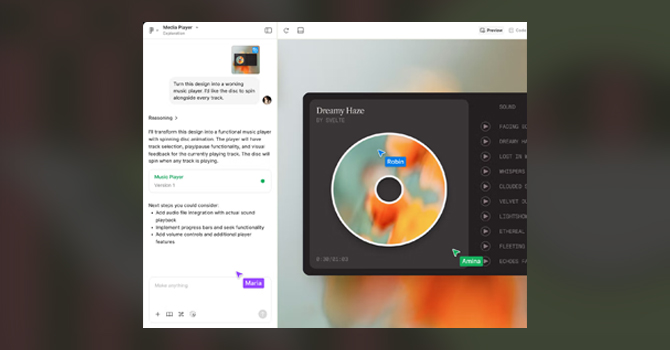Figma has officially rolled out Figma Make, its AI-powered prompt-to-app prototype tool, to all users, including those on free Starter plans. This marks a major milestone as the company moves its AI features out of beta and into general availability
Bringing AI to the Masses
Originally launched in beta for Full Seat subscribers, Figma Make enables users to generate functioning app prototypes using just plain language prompts without coding. Now, even users on lower-tier plans can experiment with drafting apps or interfaces, though publishing remains limited to Full Seat users.
This push aligns with Figma’s mission to democratize design. Their suite of AI enhancements, such as image editing, content replacement, and layer renaming, also launched out of beta, making smart tools accessible across teams and subscription levels.
How It Works
Figma Make lets designers describe their vision, attach design references (like images or Figma files), and have the tool produce prototypes that respect the original design style. Users can also refine individual elements via additional AI prompts or manual edits.
Further back-end enhancements include integration with toolchains like Supabase for building functional prototypes and extracting style context from existing Figma libraries to ensure consistent branding in generated code.
Contextual AI: Dev Mode MCP Server
In parallel, Figma introduced the Dev Mode MCP Server, now in beta. This tool provides AI and coding assistants (like Microsoft’s Copilot or Claude Code) direct access to Figma’s design data, like exact color values, graph metrics, and layout specifics, making it easier for AI to translate design into accurate code.
This deeper contextual access eliminates guesswork and brings AI tools closer to the actual design intent, improving outcomes during development.
Why It Matters
The general release of Figma Make marks a shift in how teams build apps and prototypes. Designers, developers, and product managers can now all participate in generating and iterating on high-fidelity functional prototypes regardless of technical background.
While Full Seat users benefit from unrestricted publishing and usage, all users now have access to robust AI experimentation capabilities. Shortly, Figma plans to introduce an AI credit system and unlock additional features for power users.
Figma’s move also reflects broader adoption trends: organizations are increasingly embedding AI across workflows from design to development to marketing to accelerate creativity and efficiency.
Final Thoughts
With Figma Make now available to everyone, the company has taken a bold step toward AI-powered democratization of design. Alongside Dev Mode’s MCP Server, these tools blur the line between concept and code, reducing reliance on specialized skills and speeding up the product creation process.
Whether you’re a seasoned designer, a non-technical product creator, or a developer working to implement prototypes into real-world applications, Figma’s AI tools are designed to level the playing field. Expect more updates soon; Figma isn’t slowing down in building its AI-powered ecosystem.
- Alexa+: Amazon’s New AI-Powered Digital Assistant - August 11, 2025
- 4 AI Business Models Reshaping the Enterprise Landscape - August 5, 2025
- Quora’s Poe API Unlocks Developer Access to 100+ AI Models - August 4, 2025




